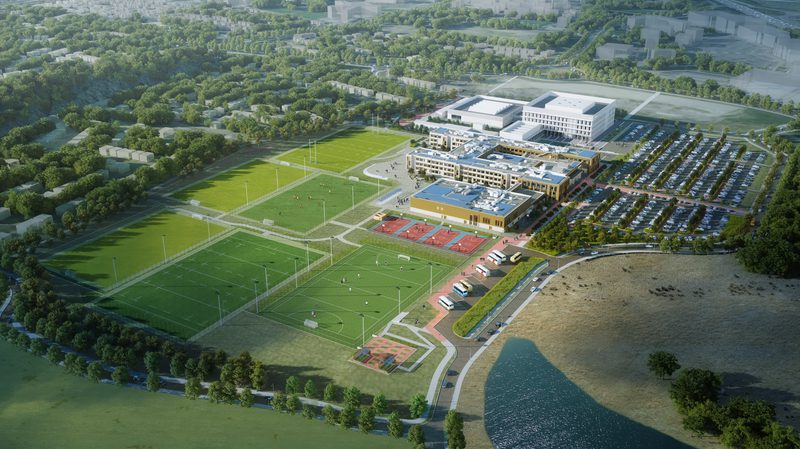Thought Leadership
How Passivhaus integration is revolutionising the UK's largest Passivhaus education building
by Jamie Gregory
Associate Director, Architecture
Set to be the UK’s largest Passivhaus education building, the new Replacement Woodmill and St. Columba’s High Schools are being delivered as part of the wider Dunfermline Learning Campus.
This project for Fife Council brings together two secondary schools into a single building, sitting on a shared site with a new Fife College building to create a new education hub.
Fife Council mandated that the new building should be designed to achieve Passivhaus Classic Certification, whilst also setting a low embodied carbon value for the project, as per RIBA 2025 targets.
As one of the first construction projects to apply the Scottish Government / Scottish Futures Trust (SFT)‘s new ‘Net Zero Public Sector Buildings Standard’, this is a SFT Pathfinder project.

Integrating Passivhaus principles from the start
From the outset and through the design development journey, Passivhaus principles were considered. This ensured architectural quality as well as seamlessly embedding the Passivhaus standards.
The importance of this approach cannot be underestimated. Not adopting this approach can pose challenges in achieving Passivhaus certification, as well as increased costs. For example, an inefficient form and fabric complexity can make insulating a building more expensive. In turn, this complexity, can cause the build process to become more challenging when working to meet the stringent Passivhaus airtightness targets.
By integrating these elements from the outset, we created a thoughtful and well-considered architectural design.
Although Passivhaus is a fundamental and an integral part of the design approach to the new school(s), design quality was always at the forefront of any decisions made.”
Jamie Gregory
Passivhaus DesignerThree key criteria were applied early in the design process to ensure the building achieves Passivhaus accreditation:
Optimisation of orientation
- A wider campus masterplan placed the school to the south and the new college to the northern portion of the site. Additionally, the creation of an education campus with focus on the learner journey placed further requirement on the siting of the school building
- A north / south orientation was chosen for the school to address the campus masterplan requirements
- This orientation also provided an opportunity to maximise / minimise solar impact. To optimise heat control and maximise solar gains, we placed the school’s teaching wings predominately north and south facing, with a majority of the glazing located on these facades. Glazing to the east and west is minimised as solar control is more difficult to control due to the low angle of the sun
- Brise Soleil to the south and vertical fins to the east and west elevations allow for solar shading in the summer whilst in the winter provides free heat due to the sun’s lower angle
Consideration of the form factor (building form)
- Creating an efficient building design from the outset creates a low form factor
- We created a simplified building form with the accommodation arranged over three floors. This minimised the exposed surface areas, achieving an efficient form factor (form factor is the ratio of thermal envelope surface area to the treated floor area (TFA))
- Key early decisions were made regarding adding in building articulation to the form which might adversely affect this form factor. Avoiding complexities such as external soffits and multiple steps in the massing helped to preserve form factor, minimise detailing issues and ensured optimal thermal performance and airtightness
- The form factor has a relationship with the thickness of insulation throughout the envelope
Airtightness
Stringent airtightness targets required by the Passivhaus standard influenced the frame selection. Although Passivhaus does not dictate a specific frame type, it is important to determine which is correct for each project.
We undertook a thorough building frame analysis at RIBA Stage 1-2 with the whole project team. This helped us to understand the best solution when balancing the key criteria of airtightness, embodied carbon and buildability.
A hybrid building frame was chosen. The three frame types are:
Precast concrete frame (for the main school building)
- This option maximised delivery of an airtight envelope and simplification of detailing. Concrete is in itself inherently airtight so it is easier to track the airtightness line through the building. The airtightness does not rely on membranes and tapes throughout the airtightness line
- Interfaces with glazing and any other apertures still require consideration
- Joints between panels are pressure grouted to maintain an airtight line. Generally concrete allows the airtight line to be on the internal face of the panels, allowing for ease of tracking and resolution of any issues throughout the build
Cross Laminated Timber (CLT) (for the sports block)
CLT is approximately five times lighter than concrete and has a much higher weight to strength ratio.
- The ground conditions where the sports block is located led to CLT being chosen
- CLT also has a lower embodied carbon compared to a concrete frame
- As a panelised system, CLT offered similar benefits to the precast concrete with simplification of detailing and an inherently airtight frame
- Joints between CLT panels are required to be made airtight. This is achieved with Passivhaus certified tapes or airtight membranes
- Adopting the outside face of the CLT panel as the airtight line enables the exposure of a clean internal timber face to be celebrated and enjoyed
Steel Frame (for the central core of the building)
- The steel frame was chosen for the central core area which required a larger span
- Steel framed buildings present significant thermal bridge implications. This affects the heating load if not properly considered
- We undertook considerable 3D thermal bridge modelling on column to foundation connections to ensure delivery of a detailed design meeting Passivhaus requirements
There was no single frame solution for this building. Given the size of the school (26,666m2), three different frames were chosen, each with their own specific reason, suiting the site and project requirements.
The build
As the Passivhaus Designer, our role has been critical, ensuring the project remains on course to meet the Passivhaus requirements. We undertake Passivhaus specific site visits. Working closely with the contractor we focused specifically on airtightness and envelope build quality.
There have been valuable lessons learnt:
- Buildability – material specification and choices versus buildability, considering the unpredictable Scottish weather
- Consideration of the airtight line - make the airtight line simple and easy to track. This assists on-site works.
- It is was also important for all site operatives to understand Passivhaus build quality requirements. Additional briefings were undertaken
- The CLT and Precast concrete frames made the build process straightforward. The airtight line is simpler and easy to understand
- Minimising the use of the steel frame mitigated the requirement for more complex detailing
- Passivhaus buildings are heavily insulated. The insulation installation is critical to the building’s overall heating balance. Thermal bridges have been modelled for the PHPP, being designed out, or mitigated
- The mechanical and electrical installation of the heat recovery ventilation system is crucial for achieving Passivhaus requirements. The quality of the installation of all heating and hot water pipework, including its insulation, is critical to ensure compliance with PHPP modelling

Lessons learnt
Passivhaus is not a bolt on solution. Consideration of key criteria early on in the design development stage is critical to achieving Passivhaus Certification. Key points to consider include:
- Integrating Passivhaus into the architectural design from the start
- Adoption of the principles of orientation and the building form will greatly support Passivhaus Certification. Both of which can be considered low cost and high impact
- Use the PHPP as a design tool to test key design solutions
- Carefully consider the building frame. Conduct robust frame analysis to arrive at the correct decision considering both Passivhaus and the individual project and site specifics
- Consider the application of detailing versus buildability. The simpler the strategy the easier it should be to build
Share on
Related Articles

Thought Leadership
Green Roofs - Did the Teletubbies have it right?
Green roofs have been around for centuries and they are far more than just an adornment to an eco-house.
Date: 2 Jun 23
by Stefan Harris
Associate, Architecture

Thought Leadership
Why we need to retrofit to achieve net zero
Retrofitting buildings is critical to decarbonisation and achieving net zero. What are the challenges, opportunities, and steps we need to take to get there?
Date: 24 May 23
by Robert Hopkins
Director, Architecture

Awards
How we're creating a better future for everyone through innovation and sustainability
We are thrilled to announce that our commitment to helping the UK reach its Net Zero Carbon ambitions has been recognised as we have been shortlisted for Architect of the Year at UKREiiF 2023.
Date: 25 Apr 23
by AHR

Thought Leadership
The Retrofit Toolkit in action
The first of our retrofit studies challenged us to propose six interventions to decarbonise a typical school building to reduce its energy usage.
Date: 3 Feb 23
by Robert Hopkins
Director, Architecture